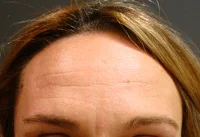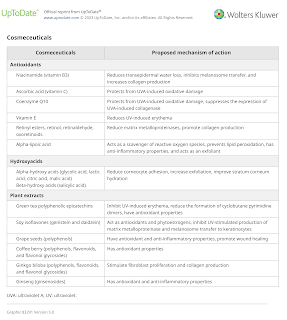Rhytides
Introduction
The appearance of rhytides (wrinkles) is a natural part of the aging process and can be seen as creases, folds or ridges in the skin.
- Wrinkles are most prominent on sun-exposed skin, such as the face, neck, hands and forearms.
Causes
Several factors can contribute to wrinkles, including
- Aging - Wrinkles develop due to the skin becoming thinner and less elastic over time.
- Sun exposure - a major cause, especially for people with light skin.
- Smoking
- Air pollutants, e.g. lead, particulate matter (soot, exhaust, industry), nitrogen oxide (car exhaust), sulphur dioxide (industry plants)
- Repeated facial expression, such as frowning, squinting or smiling
Prevention
To minimize the appearance of wrinkles,
- Photoprotection, such as always wear protective clothing or using sunscreen
- Use moisturizer
- Remove makeup at the end of the day with a cleanser to prevent the blockage of the skin pores, which can hinder the body's ability to produce collagen proteins.
- Do not smoke
- Living a healthy lifestyle, such as regular exercise, healthy diet, sufficient sleep
Treatment
While wrinkles do not require treatment, there are several options to help smooth wrinkles or make them less noticeable.
- Medications
- Topical retinoids
- It takes 3-6 months of regular use before improvements in wrinkles are apparent and the best results take 6-12 months.
- Can cause skin dryness and irritation.
- Treatment with topical retinoids should not be started or continued during pregnancy because retinoids are known teratogens.
- Cosmeceuticals
- Refers to a heterogenous category of non-prescription topical products including antioxidants, vitamins, retinol, hydroxyacids and plant extracts, that may have some activity in the treatment of photoaging.
- Limited evidence from clinical studies to suggest that they are beneficial or that one particular preparation is better than another.
- Cosmetic procedures
- Soft tissue fillers
- Include collagen, hyaluronic acid or fat
- To fill in or lift up folds or deep wrinkles.
- Botulinum toxin type A (Botox)
- Blocks the chemical signals that cause muscles to contract and cause wrinkles.
- Chemical peel
- Applying a chemical solution to the desired areas, causing the dead skin to shed and eventually peel off. The regenerated skin tends to be smoother than the old skin.
- Surgical procedures
- Laser ablative resurfacing
- Microdermabrasion or dermabrasion
- Face-lift surgery (rhytidectomy)
- Usually involves removing excessive facial skin and fat, with or without tightening the underlying tissue layers.


Comments
Post a Comment